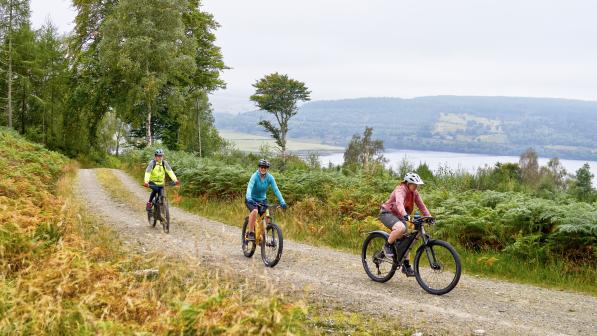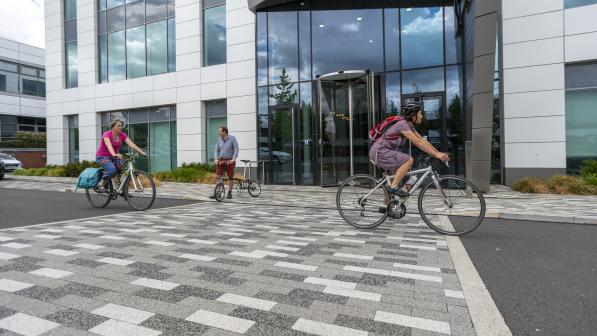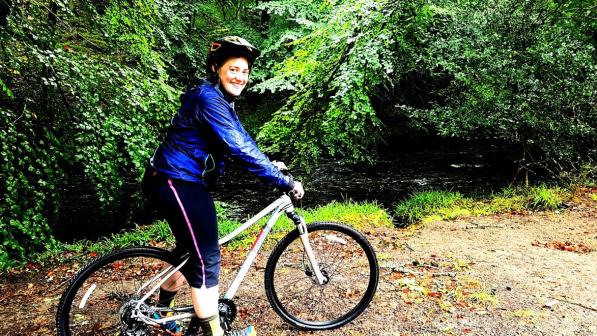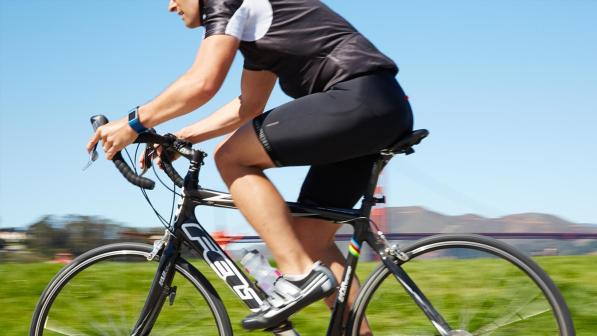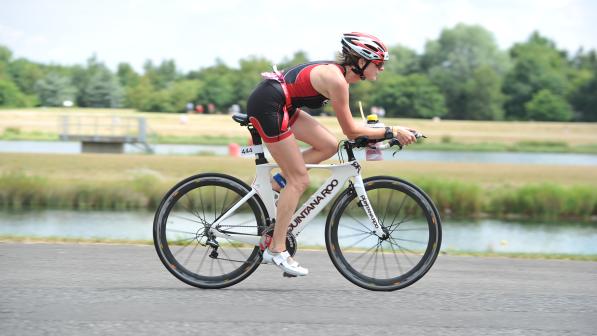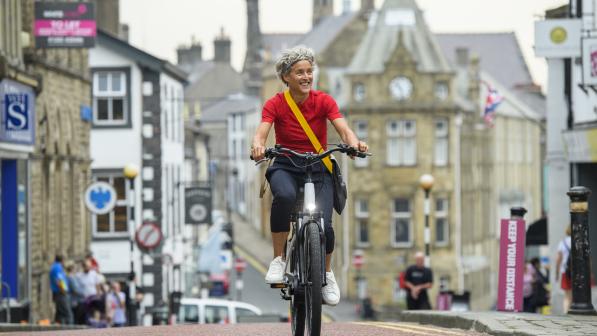How to use your cycle commute to get fit

It’s that time of year when thoughts turn to ‘self-improvement’, and high on many lists is getting fit. But finding the time and motivation to exercise regularly isn’t easy. Wouldn’t it be great if you could combine something many of us do on an almost daily basis with getting more exercise? Well, you can.
Cycling to work is a great way to get fit without having to make time to go to a gym. It also saves money on gym fees and gets you outside, with all the benefits to wellbeing that brings.
The good news is that your commute doesn’t need to be particularly long or arduous. The NHS recommends that adults aged 19 to 64 should do at least 150 minutes’ moderate intensity activity every week, ideally spread over four or five days. It also specifically mentions cycling as a moderate intensity activity.
If your commute is 15 minutes each way and you do it five days a week, that’s the minimum met – without even stepping foot inside a gym. This means that even people who combine transport types (cycling with a train journey, for example) can also hit that recommended minimum.
Be prepared
Forward planning is key. First, you’ll need a bike. Any cycle will do. If you’re already commuting, then the bike you use is ideal. If not, and you’ve got an old hybrid in the shed, that will do just fine.
But think about your own needs. If you want to combine the school run with cycling to work, you might want to invest in a cargo bike or a trailer to transport the kids. If you need to use public transport, then a folding bike is best. An e-cycle will make longer commutes easier while still providing a good workout.
You’ll also need to consider kit. You can wear your normal work clothes to ride in. But if you’re cycling for fitness, you’ll be working harder and getting much sweatier. For your own comfort – and that of your colleagues! – you might want to invest in some Lycra and change at work.
Next, work out what your goal is. Do you want to improve your fitness? Are you training for a charity ride or even a long-distance challenge? You’re much more likely to stay motivated if you’ve got something to aim for, even if that aim is simply to keep up with your fitter mates on your next club ride.

Plan your route in advance so you know exactly where you’re going, the distance and roughly how long it will take you. This is especially important if you’re new to cycle commuting. The last thing you want is to get lost and end up flustered and late for work.
Cycling UK’s Journey Planner will plot a route between two points, giving you the options of quietest, balanced and fastest routes. It also gives information such as distance, estimated time and the amount of CO2 you’ve saved by not driving.
If in doubt, test your route on a weekend when you’ve got more time so that you can take it slowly and safely without the worry of being late.
Keeping track of your efforts is motivational and helps you monitor your fitness. You don’t need an expensive Apple Watch or Garmin (although these are great if you have them). There are plenty of free apps you can download to your phone that show you how far you’ve gone and how quickly, logging things like effort and calories burned. Strava is one of the most popular among cyclists.
Mix it up
To make the most of your commute you’ll want to vary your routes, finding longer rides, over different terrains if possible, and ideally throwing in the odd climb. This will both increase your fitness and make your ride more interesting – essential if you want to stay motivated.
Once you’ve established your shortest journey, it’s easy to explore and find new ways to go. Google Maps will help you identify potential longer routes – again, you can test these on a non-working day so you know exactly where to go and how long it will take.
Urban commuters might find it challenging to change terrain much, but cycling through parks and along canals can add variety. Country cyclists have it much better here – you might even find a totally off-road route.
Multi-modal travellers can also vary their routes. Try getting off the bus or train one stop earlier, and keep doing this until you’ve extended your ride as much as possible. You can try longer routes between home or office and train station, too.
Climbs are an excellent way to increase power output. Adding one or two to some of your rides will really get your heart rate up. Remember that the bike is powered by you and that includes anything carried on the bike, or on you. Any spare clothing, shoes, laptop, or anything else you need for work adds to the weight that your legs have to propel you with to get to and from the office.
Take it slowly, though, and gradually build up to longer rides as you get fitter. Another top tip is to leave the longest rides for the way home when you’re less pressured to arrive on time. The days are starting to get longer now, so it’s the ideal time to increase time in the saddle.
Once you’ve got an arsenal of different rides, it’s a good idea to draw up a training plan – even if it only exists in your head. Alternate longer, more challenging rides with shorter, easy ones to give your body enough time to recover.
Moderate cycling – the kind that you might do on a commute – burns about 300 calories per hour; you can get an estimate for how many calories you burn on your commute using an online calorie calculator.
There are ways to increase this. Most of us have heard of high intensity interval training or HIIT as a way of increasing an activity’s intensity, and it’s something that can be done on your commute.
Find a longish, straightish road with as few traffic lights as possible – tricky on urban commutes, but not impossible – and use this for some interval training. Pedal as hard as you can for 20 seconds, then back off for 40 seconds. Repeat this as many times as you can on your chosen road. If you can, identify three or four roads for this on one of your longer rides.
In between, ride normally. As you get fitter you can increase the time spent at higher intensity. If you can, increase to a minute at high intensity, with 30 seconds of rest. You’ll find your cardiovascular health improving all the time.
Urban commuters can use the stop-start nature of riding in traffic to focus on high-intensity speed in between pauses. You can also use those red lights: practice your track stand skills (that is, staying on your pedals while stationary) and then an explosive sprint start as the lights turn green. This will help build strength in your legs.
Off the bike
To really maximise your fitness, you’ll want to pay attention to what you do off the bike too. Cycling is excellent cardiovascular exercise, but you should complement it with alternative activities. Yoga is particularly good for cyclists. Any repetitive action like cycling risks overworking some muscle groups; yoga balances this out and stretches and lengthens muscles, helping prevent injury.
The NHS recommends a couple of strength-building sessions a week. These can be body weight or using weights. If you’ve got the space, YouTube is a fantastic resource for free workouts, plenty of which don’t require any special equipment. Just search for ‘body weight workout’.
It’s important to complement your new exercise regimen with a healthy diet, and that includes making sure you’re properly fuelling your rides. You’ll need a good mix of carbohydrates and protein, as well as plenty of fruit and vegetables.
Diet is beyond the scope of this article, but Cycling UK has plenty of great advice on how to fuel your rides, as well as top tips from nutritionist Jesse Lambert-Harden.
Homemade healthy snacks are an effective way of staving off hunger pangs without breaking the bank. We’ve some great recipes that you can follow.
Rest time is just as important as your workouts. Your health and fitness are a long-term investment; make sure you look after yourself. You need to give your body time to recover from your efforts, and overtraining will leave you exhausted and prone to injury.
When putting together your training plan, make sure you alternate longer rides with shorter ones that you can take more slowly. You should also include rest days on which you only do some light yoga or go for a walk.
Stay safe
None of this is an excuse to run red lights or put your head down and ignore other road users while you’re watching your power meter. You still need to follow the rules of the road.
Be aware of other road users, especially when in heavy traffic or moving at speed. Ride to the conditions, and adapt your riding style where necessary. If that road you usually use for interval training is chock-a-block with traffic, then drop your intervals this time around. It’s not worth taking risks.
Remember that the Hierarchy of Responsibility applies to cyclists, too. The last thing any of us want is to hit a child running across the road because we’re paying more attention to the bike computer or smartphone that’s attached to our handlebar than to what’s going on around us.
Virtual commute
But what about those of us who don’t travel to work anymore? This is where the virtual commute comes in. This is something that came out of lockdown when we were trapped at home and only allowed to get outside for essential or exercise trips.
The idea is to do a ‘pretend’ commute – go for a ride at the beginning and end of the working day as if you were cycling to work. All the same advice applies, and you’ll get all the same health benefits, but instead of riding from A to B and back again, you’ll be starting and ending at home.
You can plot a mix of circular and linear ‘there and back’ routes of varying lengths and difficulties to keep things interesting. You can set yourself challenges such as how far you can go within a particular time or how quickly you can do a chosen distance. You also have the flexibility of going out at lunchtime rather than after work while waiting for the evenings to get lighter.
